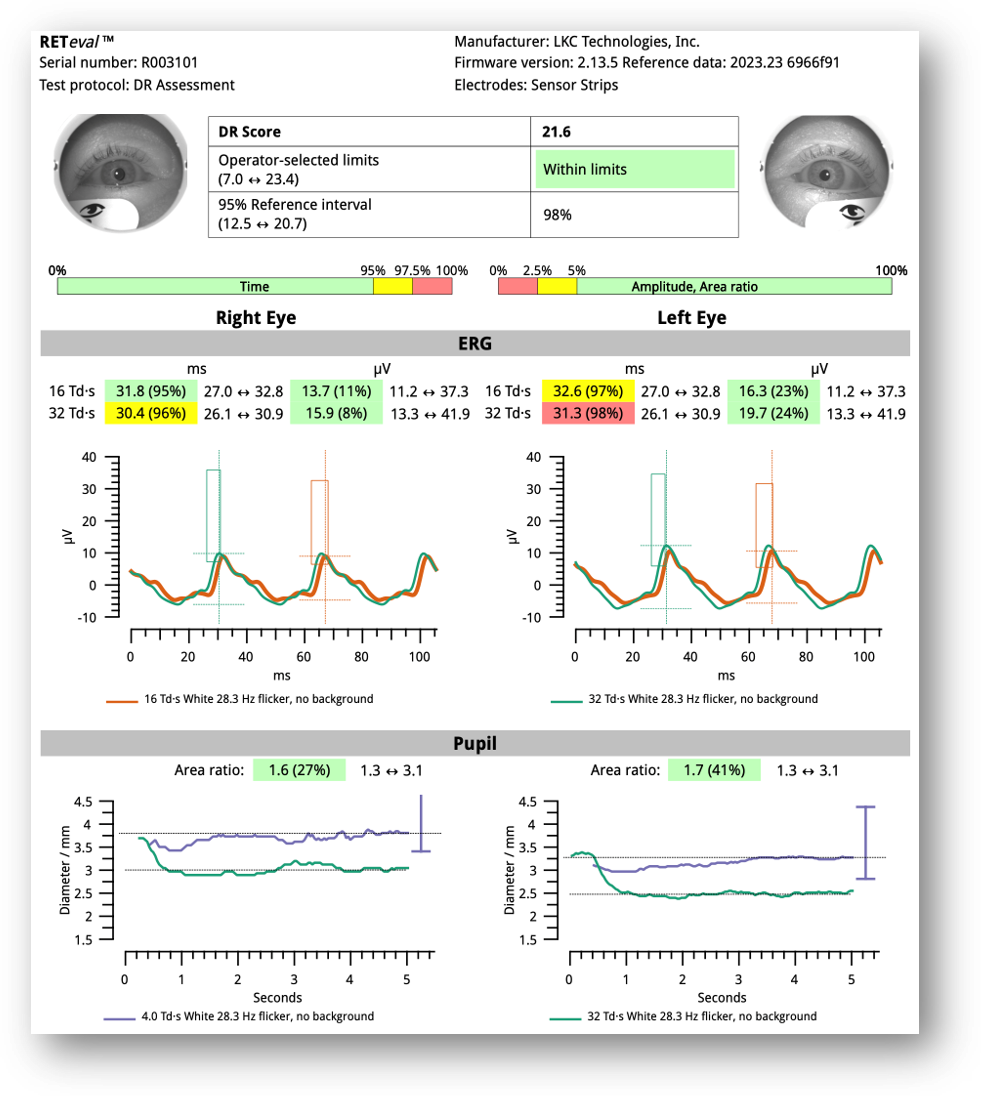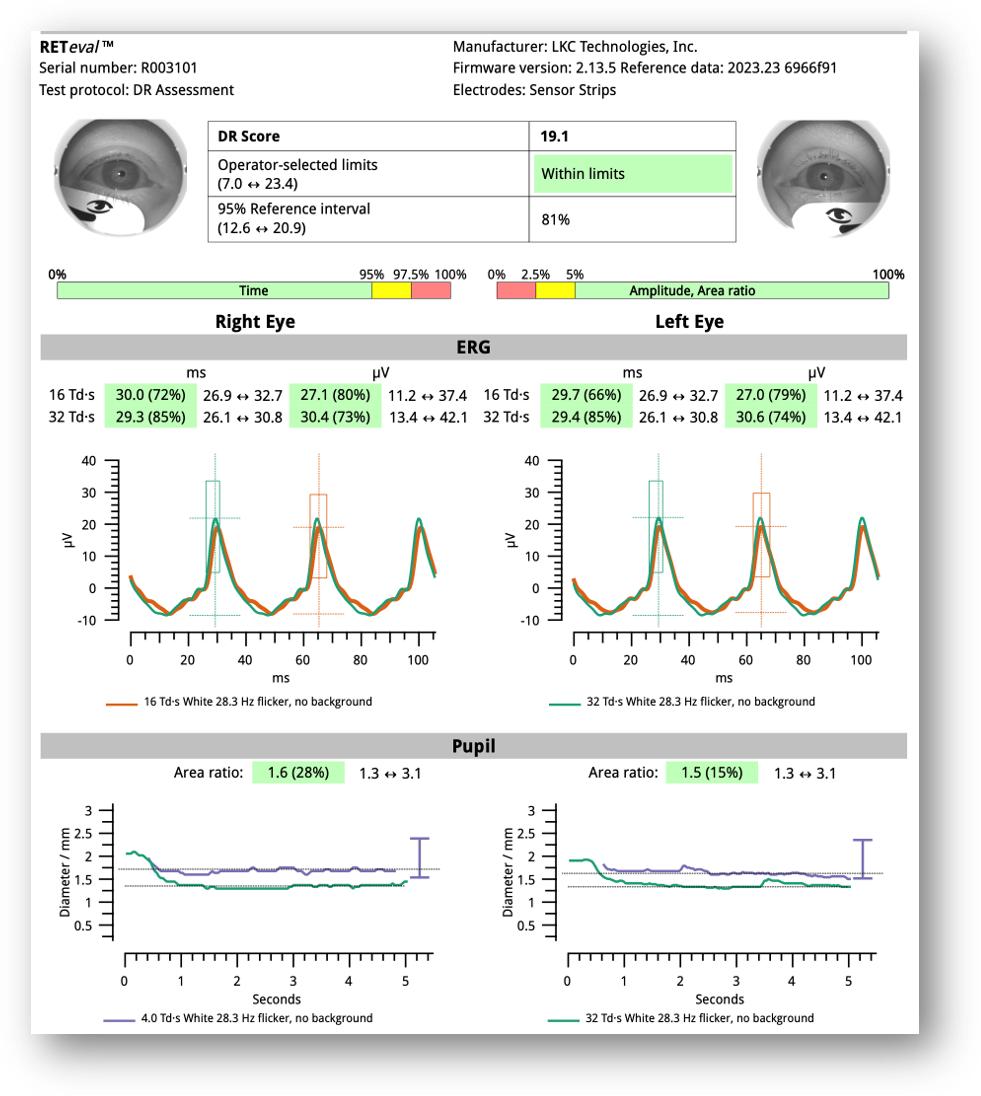Caso de Estudio
Vision Complaints Reflected on ERG
by Nate Lighthizer, OD, FAAO
Despite reduced visual acuity that he reported as bothersome, one patient with a longstanding history of diabetes was reluctant to make lifestyle changes in order to improve his vision. Although there were no changes evident on OCT, optometrist Nate Lighthizer, OD, FAAO, was able to leverage the RETeval handheld ERG’s objective DR Score to convince the patient to begin nutritional supplementation, which ultimately led to an improved DR Score at later appointment.
Watch the video of Dr. Lighthizer presenting his case or review the case below.
Patient History
A 77-year-old male with a 19-year history of diabetes mellitus, controlled with oral medications, presented to our clinic. His most recent A1C was 8.2, which is a little higher than we would like it to be, but when we attempted to discuss diet and exercise, the patient indicated that he didn’t care to make changes and expected his A1C to stay at that same level.
His visual acuity was 20/20-3 OD and 20/30+2 OS. Fundus exam revealed mild non-proliferative diabetic retinopathy OD, with a small microaneurysm (Figure 1).
Figure 1:

Why Was the ERG Test Performed?
Based on the OCT (Figure 2), we would expect this patient to have 20/20 vision, yet he had reduced visual acuity in the left eye and was complaining about it, particularly as it compared to the reduced vision in his right eye.
Figure 2:

What Were the ERG Findings?
Although the DR Score is less than 23.5 at 21.6, the implicit times are flagged as borderline and abnormal, which is indicative of cellular stress. In addition, the DR Score of 21.6 does fall outside of the 95% reference interval for this patient’s age group, which alerts us to this being a borderline ERG result (Figure 3).
Figure 3:

How Did the ERG Impact Next Steps?
Based on these findings, I was able to discuss the impact that better nutrition might have on vision moving forward. Although the patient was not motivated to change his diet, he was disappointed with his vision and was amenable to taking a supplement for retinal health.
I saw the patient back in six months and then again at one year. He reported using the supplement regularly, but as he predicted, his A1C and diet remained unchanged. However, at the one-year follow-up, I repeated the ERG and saw notable functional improvement in the implicit time and amplitude of the ERG, and the DR Score decreased (Figure 4).
Figure 4:

This case was billed using E11.329 – diabetes with mild non-proliferative retinopathy w/o macular edema based on medical necessity.
Why We Use RETeval
I began using ERG technology during my residency and was later invited to take over as the Chief of Electrodiagnostics by the Oklahoma College of Optometry in 2010. In 2023, we acquired our first RETeval device. We love it because it provides objective functional data that we can take right to the patient, and because the DR Assessment is performed on undilated eyes, the RETeval improves our patient flow. In just a few short minutes, you can obtain objective functional data for both eyes. This information gives me assurance about overall retinal function.
Practice Protocol
I believe an ERG should be performed for all patients with diabetes who have:
- Any degree of structural change
- Uncontrolled disease
- Vision changes
- Diabetes for more than 5 years

Nate Lighthizer, OD, FAAO
Northeastern State University (Tahlequah, OK)
Dr. Lighthizer serves in multiple roles as a faculty member of the Oklahoma College of Optometry, including Chief of the Electrodiagnostics Clinic, Director of Continuing Education, and founder and head of the Dry Eye Clinic. He is a founding member of the Intrepid Eye Society, a group of emerging thought leaders in optometry, and currently serves as Vice President. Dr. Lighthizer is a nationally recognized speaker on topics such as advanced ophthalmic procedures, ocular disease, and electrodiagnostics.



